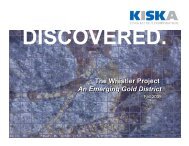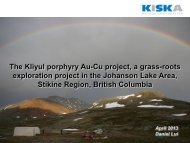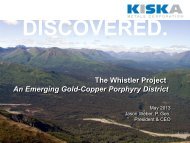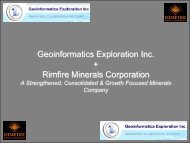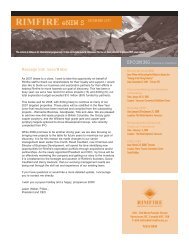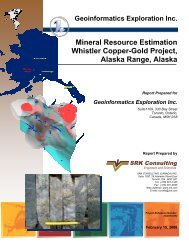view FS - Kiska Metals Corporation
view FS - Kiska Metals Corporation
view FS - Kiska Metals Corporation
Create successful ePaper yourself
Turn your PDF publications into a flip-book with our unique Google optimized e-Paper software.
KISKA METALS CORPORATION<br />
MANAGEMENT’S DISCUSSION AND ANALYSIS<br />
For the three-month period ended March 31, 2012<br />
1.1 About <strong>Kiska</strong><br />
<strong>Kiska</strong> is a mineral exploration company with a large portfolio of assets anchored by the Whistler<br />
Project, a multi-million ounce gold resource in Alaska. In addition to Alaska, the Company<br />
concentrates exploration efforts in British Columbia, Canada, and Australia, and has property<br />
interests in Nevada, USA and the Yukon Territory, Canada. The Company strives for the<br />
highest technical expertise in exploration combining an innovative targeting approach developed<br />
by the Company since its inception with more traditional exploration methods. <strong>Kiska</strong> is listed on<br />
the TSX Venture Exchange, trading under the symbol KSK.<br />
Over the past several years, the Company has acquired a portfolio of exploration projects from<br />
its own exploration activities and under the Master Strategic Alliance Agreement (“MSAA”) with<br />
Kennecott Exploration Company (“Kennecott”). When <strong>Kiska</strong> acquired Rimfire Minerals<br />
<strong>Corporation</strong> in 2009, a large portfolio of early stage exploration projects was added to the<br />
Company. At the same time, the Company acquired management with experience and<br />
expertise in deriving value from projects through option or joint venture arrangements.<br />
1.2 Over<strong>view</strong><br />
Efforts for the three-month period concentrated on compilation of data collected in the 2011<br />
exploration programs, reporting on the findings of those programs and preparation for the 2012<br />
field season. This included reports from 30,304 metres of drilling completed on the Whistler<br />
Project in 2011, as well as programs completed at the Kliyul, Redton (geophysics and<br />
geochemistry) and Gillis (trenching) projects.<br />
During the period, partner Brixton Resources reported results of the 21-hole Thorn drilling<br />
program, completed in the fourth quarter of 2011. This program was highlighted by a high-grade<br />
silver-gold-base metal intersection at the Oban Breccia Zone.<br />
Exploration of the Whistler Project in 2011 included drilling on three target areas (Whistler Orbit,<br />
Island Mountain and Muddy Creek) as well as “regional” exploration of less mature areas of the<br />
property. Exploration drilling in the Whistler Orbit confirmed the presence of multiple Whistler<br />
“look-alike” targets in the vicinity of the deposit. These targets (Raintree West, Raintree North,<br />
Raintree South, Rainmaker) are geologically similar to Whistler with respect to host intrusive<br />
rocks, style of mineralization, gold-copper grades and overall alteration patterns. These<br />
similarities indicate a common genetic association and a cluster of related porphyry centres. In<br />
conjunction with the scale over which distal porphyry style alteration occurs in the Orbit,<br />
management is led to believe that additional porphyries may be present as part of this cluster.<br />
2011 drilling at the Raintree West prospect defined two zones of porphyry mineralization. The<br />
first is a 150 metre long by 125 metre wide zone of near surface mineralization that occurs to a<br />
depth of 170 metres. Magnetic data indicates this zone may extend to a strike length of 250<br />
metres at surface. The second, deep zone has a an apparent width of 300 metres with 325<br />
metres of strike extent and is open at depth, A significant mantle of epithermal-textured quartzcarbonate<br />
base metal veins surround and overlap gold-copper mineralization at Raintree West .<br />
Drilling activities further defined the Rainmaker prospect, and led to the discovery of the<br />
Raintree North and Raintree South prospects. All three are near-surface and appear to be<br />
moderately to steeply dipping 100 metre-wide bodies of gold-copper mineralization. Faulting<br />
bounds the<br />
3



